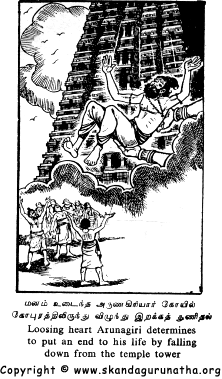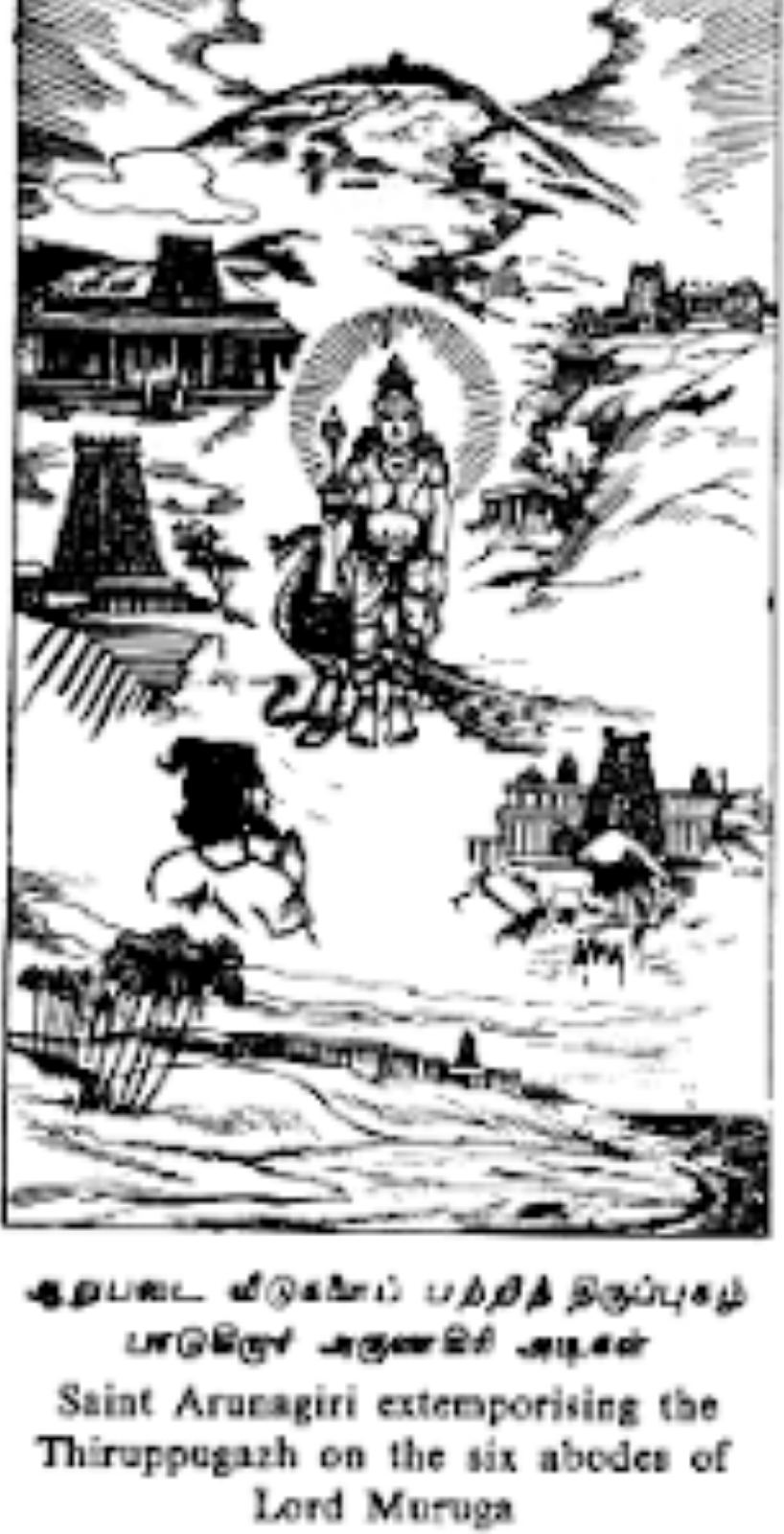
Although music had always been an integral part of the Tamil hymns such as Tevaram, Arunagirinathar was one of the first to set all his compositions to music in the style of "Santham"-setting the verses within a certain length to conform with rhythm ( thala). The poet Arunagirinathar represents a remarkable blend of Tamil literary genius, devotion to Murugan and musical expertise. This appropriation of secular imagery to religious purposes is characteristic of the Thiruppugazh: just as it call people to turn from hedonistic pleasures to a life centred on God, it turns the language formerly used to celebrate carnal love to celebrate God. The union which Arunagirinathar uses this to symbolise, however, is that of the soul with God, and the imagery specifically calls to mind the legend of Murugan's wooing of Valli, the daughter of a Kurava chief. In secular poetry, the image of bees entering flowers symbolises the clandestine union of lovers, and the backdrop of the hills calls to mind the raw forces of nature. The reference to Kuravas and hills, and the imagery of the bees making honey from scarlet ceccai flowers, are characteristic of the kuriñci landscape. Who wields the spear which destroyed the majestic hill Who protects the Kurava woman of the sweet, child-like words

I do not wish to dwell in this illusory body,īuilt of the sky, water, earth, air, fire and desires.Įnlighten me, that I may praise the glory of your holy name The imagery used in the following verse is illustrative of this usage: Whereas akam poetry uses the imagery in the context of secular, sensuous love, the Thiruppugazh uses the same imagery in the context of the longing of the individual for God. The usage is not, however, straightforward. The Thiruppugazh makes extensive and deliberate use of the imagery associated with the five landscapes of classical akam poetry. Its metres, too, are more obviously rhythmical than the stylised classical metres. The Thiruppugazh, in contrast, was written in a form of Tamil that was quite different from pure classical Tamil. The songs also deal with issues of morality and living a virtuous life on Earth, with many exhorting people to seek true happiness in God.Įarly mediaeval Tamil religious poems were written in a language and style that followed the pattern of classical Tamil literature. The songs contain philosophical musings on God, expressed in simple terms, placing particular emphasis on the role of God's grace or mercy in helping the individual deal with the troubles and ills that afflict humanity. Arunagirinathar says in the Thiruppugazh the songs will, by the grace of Murugan, convey the pearls of devotion and wisdom.
#ARUNAGIRINATHAR THIRUPUGAL TAMIL FULL#
Murugan is described as being full of love and compassion. Arunagirinathar's songs build on this tradition, hailing Murugan as the source of all knowledge, who even gave saintly advice to his father, Lord Shiva. According to Tamil legends, Murugan was the brave warrior who defeated the powerful demon Soorapadman, and was seen as being the epitome of youth, compassion and beauty. The worship of Murugan has strong roots in Tamil Nadu. Almost all songs end addressing Murugan as Perumal, a term that traditionally had strong associations with Tamil Vaishnavism. The majority of the songs are sung to Murugan, but there are also a few songs that sing of deeds of Siva or the avatars of Vishnu, and of the power of Parvathi. At each of these, he composed songs in praise of Murugan, which are collected together in the Thiruppugazh. Arunagirinathar was transformed, and began a long pilgrimage, visiting the Arupadai Veedu ( Six Abodes of Murugan), the six temples most sacred to Murugan, and over 200 other holy shrines in India and Sri Lanka. He was saved by a stranger, who, according to legend, was Murugan himself. His disgust at his own conduct led him to attempt suicide by jumping off the temple tower at Thiruvannamalai.

According to these, Arunagirinathar led a hedonistic life as a young man.

There are no historical records of the life of Arunagirinaathar, and what we know of the composition of the Thiruppugazh is largely derived from oral traditions and legends recorded in commentaries on the work. ( July 2020) ( Learn how and when to remove this template message) Unsourced material may be challenged and removed. Please help improve this section by adding citations to reliable sources.


 0 kommentar(er)
0 kommentar(er)
